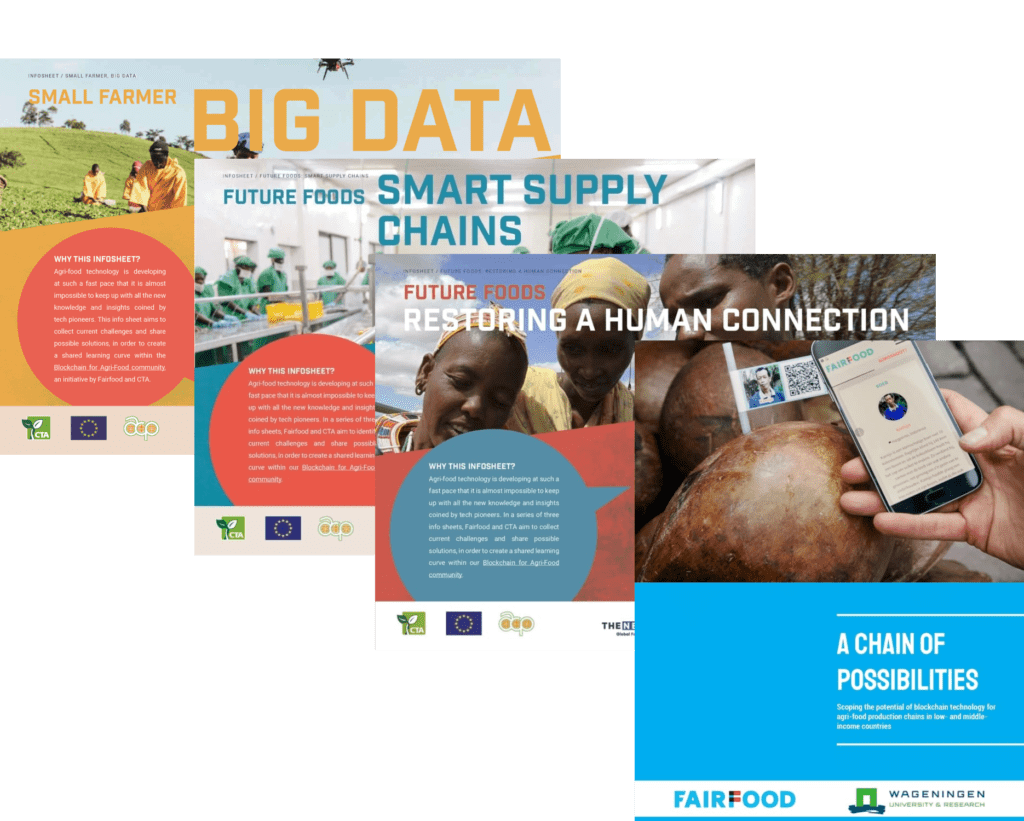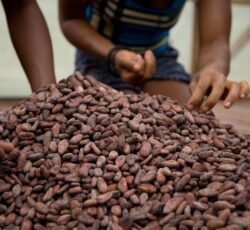8 questions about the implications of blockchain for a farmer’s income
Last month, we at Fairfood organised the first Blockchain for Agri-Food community webinar in cooperation with CTA and Strike Two Summit. Together with Agri-wallet and El Kanis & partners, we explored the implications of blockchain for a farmer’s income.
During this webinar, we received a lot of relevant questions that help to better understand the mechanism behind the technology, its potential and its restraints for now. We selected the eight most burning question and hope these will cater to everyone who is just entering the exciting world of blockchain for agri-food (in specific blockchain for a farmer’s income).
Moreover, we hope the answers to these questions will provide you with a solid base to participate in our brand-new community: Blockchain for Agri-food. Within this community, through webinars, blog posts, reports and an interactive Slack channel, we will actively share blockchain knowledge and insights throughout the entire spectrum of agri-food – from consumers to food businesses and producers in low- and middle-income countries.
Missing a question? Let us know and we’ll make sure to get back to you with an answer.
- In regard to digital identity and the possibility to create a “digital passport” through a chain of payments, for example, the digital product passport is part of a virtual reality, whereas the product itself is part of the physical world; how does one verify and connect the physical to the digital?
There is a variety of ways of verifying and thus establishing a link between the physical product and its digital counterpart: QR code scanning is one of them. QR code scanning allows to identify actors on your platform and connect their “real” identity to their “blockchain identity” since each person has an individual private key to access. The unique QR code not only is able to verify identity but thus connects the physical to the digital.
New nanotechnologies are also in development that strengthen the link between the digital and physical products. Examples are “chemical traceability” where products are traced back with the use of non-harmful chemical infusion or microchips and sensors attached to products. The vast majority of these nanotechnological developments are presently either too expensive or too unfeasible to implement on a commercial scale, but the intent to increase the food/product traceability remains.
- What can be done about the “garbage-in garbage-out” problem? In other words, how is the information that is first registered on the blockchain verified?
It is possible to validate the information registered on blockchain by verifying ID firstly and secondly by aligning incentives, i.e. by incentivising users to upload correct info and to signal incorrect data. This can be done, for example, by attaching real money value to blockchain transactions. Furthermore, smart contracts – automatically executing contracts on a blockchain – can both define and directly control the rules and fines related to an agreement and automatically enforce these obligations, thus avoiding fraudulent or incorrect information to be registered.
Another way of preventing wrong data entry is to track volumes that go in and out of a specific company in the chain and see if these match with the expected conversion ratio. To give an example: a company that dries cocoa beans can never sell the same volume of produce as it has purchased. After all, dried cocoa beans weigh less than wet cocoa beans. The outflow should be less than the inflow of produce, in relation to the average conversion ratio related to the process. By matching the volumes that go in and out of a company, it becomes very hard for individual companies to enter false or wrong data as it has to be confirmed by the purchasers and suppliers of that company, and has to be in line with the average conversion rate of the process in order to be “verified” by the system.
- What happens if you make a mistake in a blockchain?
One of the main features of blockchain is immutability: recorded data cannot be changed retroactively without the consensus of the majority of the network. In other words, you cannot erase mistakes. This grants a high level of transparency with every action that takes place within the blockchain. In the application layer, it is possible to add the option of “reverting the mistake” by creating a new transaction that automatically sends back tokens which have been accidentally sent. However, the incorrect information or transaction will forever be recorded on the blockchain.
- Aren’t blockchains very unsustainable and energy consuming?
Most blockchains nowadays don’t actually consume a lot of energy. The level of energy consumption depends on the consensus algorithm. The first blockchain based product, bitcoin, uses computing power to secure its network. This is called proof of work. However, most industry grade blockchains nowadays use proof of stake. Proof of stake uses significantly less energy consumption as it uses the value of the digital tokens themselves to secure the network.
Proof of work is the most reliable way to secure a blockchain network but has a very high energy consumption. However this can also be put in perspective. Bitcoins energy consumption always gets compared to low energy consuming countries which makes it look like a lot. A more equal comparison should be made, for example the comparison between gold mining energy consumption and bitcoin mining energy consumption. Although gold has industrial use cases, most of its value is derived from its capability to provide a reliable store of value, very similar to bitcoin. According to a Zero hedge article from 2017, gold mining consumes almost 20 times more energy than bitcoin.
- What is the benefit for smallholder farmers of using a blockchain-based solution compared to a centralised one?
By making use of blockchain technology and cryptocurrencies, solutions can be used anywhere in the world, without being depended on local financial infrastructure. Also, blockchain technology can automate agreements and record transactions in a transparent and immutable way. This is particularly useful for smallholder farmers who often struggle to get access to financial services and don’t have the means to prove themselves online. By making use of blockchain technology, farmers can build up a track record of trust over time which they can use to get access to (financial) services previously inaccessible to them. It also lowers the risk of fraud towards farmers as data and transactions in a blockchain cannot be counterfeited afterwards.
- Why can’t cryptocurrencies be used as a form of payment within the supply chain?
Cryptocurrency transactions significantly decrease costs for cross-border money transfer, avoiding the steep fees charged by traditional financial institution. Theoretically, it is possible to use cryptocurrencies within the supply chain as a form of payment. However, it has not been implemented yet due to a series of difficulties such as fear of noncompliance, different regulations per country/governments around cryptocurrency, and the need for proper infrastructure to safely use, pay with and convert cryptocurrency to cash.
- What tools does the smallholder farmer need to be able to enter data into the blockchain?
It depends on the solution provider and the data needed. For example, Fairfood’s platform requires the bare minimum: a mobile phone device that is able to send SMS confirmations of payments. The platform will then automatically record the confirmation on a blockchain. It is important to acknowledge that the further away the device is from the blockchain system, the higher the risk of fraud. This is explained in Fairfood’s chain of possibilities report. Thus, there clearly still is a trust element involved in this transaction with the service provider, a trust element that can be minimised by using for example passwords, pin codes or fingerprints.
- How does one prove that unmonitored negative side effects of food production can also be dealt with in a blockchain-based supply chain? If for example you only monitor whether effective payments took place, many social sustainability issues would still remain unresolved. In this sense, blockchain could also create a false sense of sustainability?
This question relates very much with question 2. As we’re only at the beginning of experimenting and finding out the potential and transformative power of blockchain technology, this question is best to be answered in five to ten years.
It is theoretically possible to design a system with the purpose of verifying virtually any type of claim. Every product claim has an authority, a criteria, and proof that can be connected to a blockchain; thus, every blockchain platform can be set up in a way that allows for the verification of proof with the right authority, and to check if that criteria has been met. The dangers of believing in a “one-fits-all”, perfect and final ethical practice are to be kept in mind: no such thing exists. It is indeed not easy to verify all sustainability claims, however the first step lies in knowing where your product comes from, what path it has taken to get to you and how well the people on its journey have been treated.
With special thanks to Agri-Wallet and El-Kanis, who participated in the webinar on farm income and inspired the participants to send in their questions about blockchain for a farmer’s income.
Find out more
—
This article is made possible with the financial assistance of CTA (Technical Centre for Agricultural and Rural Co-operation). The views expressed above can in no way be taken to reflect the official opinion of CTA.



